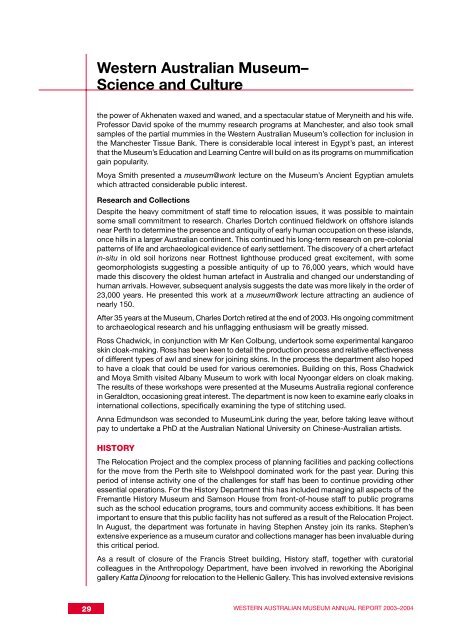Western Australian Museum Annual Report 2003-2004
Western Australian Museum Annual Report 2003-2004
Western Australian Museum Annual Report 2003-2004
You also want an ePaper? Increase the reach of your titles
YUMPU automatically turns print PDFs into web optimized ePapers that Google loves.
29<br />
<strong>Western</strong> <strong>Australian</strong> <strong>Museum</strong>–<br />
Science and Culture<br />
the power of Akhenaten waxed and waned, and a spectacular statue of Meryneith and his wife.<br />
Professor David spoke of the mummy research programs at Manchester, and also took small<br />
samples of the partial mummies in the <strong>Western</strong> <strong>Australian</strong> <strong>Museum</strong>’s collection for inclusion in<br />
the Manchester Tissue Bank. There is considerable local interest in Egypt’s past, an interest<br />
that the <strong>Museum</strong>’s Education and Learning Centre will build on as its programs on mummification<br />
gain popularity.<br />
Moya Smith presented a museum@work lecture on the <strong>Museum</strong>’s Ancient Egyptian amulets<br />
which attracted considerable public interest.<br />
Research and Collections<br />
Despite the heavy commitment of staff time to relocation issues, it was possible to maintain<br />
some small commitment to research. Charles Dortch continued fieldwork on offshore islands<br />
near Perth to determine the presence and antiquity of early human occupation on these islands,<br />
once hills in a larger <strong>Australian</strong> continent. This continued his long-term research on pre-colonial<br />
patterns of life and archaeological evidence of early settlement. The discovery of a chert artefact<br />
in-situ in old soil horizons near Rottnest lighthouse produced great excitement, with some<br />
geomorphologists suggesting a possible antiquity of up to 76,000 years, which would have<br />
made this discovery the oldest human artefact in Australia and changed our understanding of<br />
human arrivals. However, subsequent analysis suggests the date was more likely in the order of<br />
23,000 years. He presented this work at a museum@work lecture attracting an audience of<br />
nearly 150.<br />
After 35 years at the <strong>Museum</strong>, Charles Dortch retired at the end of <strong>2003</strong>. His ongoing commitment<br />
to archaeological research and his unflagging enthusiasm will be greatly missed.<br />
Ross Chadwick, in conjunction with Mr Ken Colbung, undertook some experimental kangaroo<br />
skin cloak-making. Ross has been keen to detail the production process and relative effectiveness<br />
of different types of awl and sinew for joining skins. In the process the department also hoped<br />
to have a cloak that could be used for various ceremonies. Building on this, Ross Chadwick<br />
and Moya Smith visited Albany <strong>Museum</strong> to work with local Nyoongar elders on cloak making.<br />
The results of these workshops were presented at the <strong>Museum</strong>s Australia regional conference<br />
in Geraldton, occasioning great interest. The department is now keen to examine early cloaks in<br />
international collections, specifically examining the type of stitching used.<br />
Anna Edmundson was seconded to <strong>Museum</strong>Link during the year, before taking leave without<br />
pay to undertake a PhD at the <strong>Australian</strong> National University on Chinese-<strong>Australian</strong> artists.<br />
HISTORY<br />
The Relocation Project and the complex process of planning facilities and packing collections<br />
for the move from the Perth site to Welshpool dominated work for the past year. During this<br />
period of intense activity one of the challenges for staff has been to continue providing other<br />
essential operations. For the History Department this has included managing all aspects of the<br />
Fremantle History <strong>Museum</strong> and Samson House from front-of-house staff to public programs<br />
such as the school education programs, tours and community access exhibitions. It has been<br />
important to ensure that this public facility has not suffered as a result of the Relocation Project.<br />
In August, the department was fortunate in having Stephen Anstey join its ranks. Stephen’s<br />
extensive experience as a museum curator and collections manager has been invaluable during<br />
this critical period.<br />
As a result of closure of the Francis Street building, History staff, together with curatorial<br />
colleagues in the Anthropology Department, have been involved in reworking the Aboriginal<br />
gallery Katta Djinoong for relocation to the Hellenic Gallery. This has involved extensive revisions<br />
WESTERN AUSTRALIAN MUSEUM ANNUAL REPORT <strong>2003</strong>–<strong>2004</strong>
















